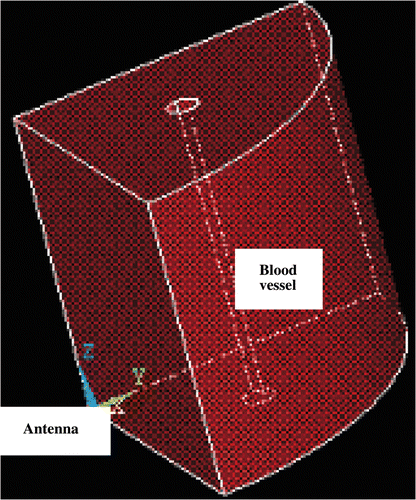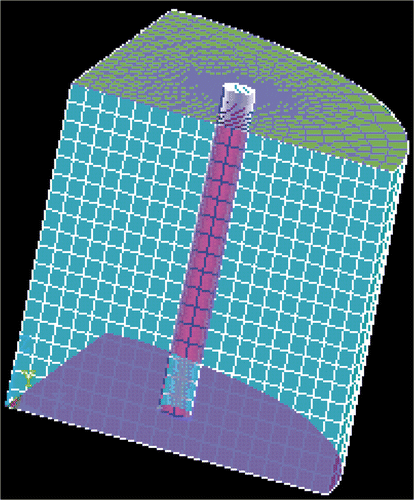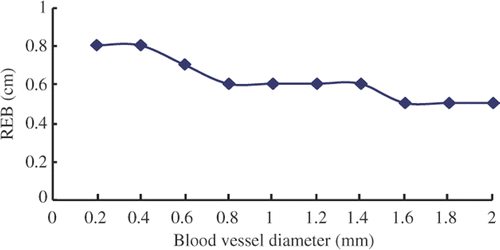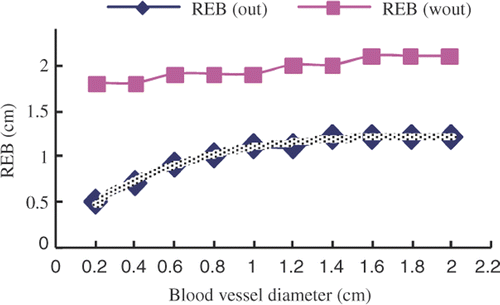Abstract
To study the effect of large blood vessels on the temperature field in invasive microwave ablation, a finite element method was applied based on the convective-type boundary condition on the interface between tissues and blood flow. Whether a large blood vessel is outside of or involved in the lesion area will affect the 54°C effective therapeutic area in different critical conditions. This paper drew the function diagraph on the distance between blood vessel and antenna with the diameter of the blood vessel and put forward the concept of effective therapy radius. It can be used to study the influence of large vessels on the external boundary of the coagulation area and can be used as a theoretical basis to help to decide whether to occlude the large vessels before microwave ablation therapy.
Introduction
Microwave ablation therapy has been widely applied for the treatment of liver tumours. In 1994, Seki Citation1 first reported a clinical study on invasive microwave coagulation therapy for small liver tumours with ultrasound monitoring. Because the coagulation lesion was long and narrow in dimension, this treatment was regarded to be only effective for small liver tumours with diameters of <2 cm.
A specific microwave antenna was developed to make a larger lesion area (depth = 4 ± 0.5 cm) × (width = 5 ± 0.5 cm) Citation2. The lesion boundary was characterised as isothermal contour of 54° ± 0.5°C.
It was found in clinical practice that tumours near large vessels often grow rampantly. The blood flow carries the heat away, which results in a cool area with a temperature lower than 54°C, and the tumours in this area couldn’t be destroyed in one application of ablation therapy, therefore some of them remain. So before using microwave ablation therapy large vessels have to be blocked to avoid their influence.
Thus, further research on the status of blood stream in the liver, especially in large blood vessels near the cancer become a serious task. Because the state of blood flow significantly influences the size of the coagulation area and the blood flow status of different patients is quite diverse, at present the influence of large blood vessels on thermal therapy is estimated on the basis of experience.
The impact of large blood vessels on heat transfer of surrounding tissue has been one of the concerns of the past few years Citation3–7. The effect of large blood vessels on lesion formation during cardiac ablation has been discussed in detail Citation7–8. For microwave ablation therapy, this issue has been discussed at length by Brace and Lee Citation19. Mean isoperimetric ratio (a measure of roundness) for all ablation zones was 0.88 ± 0.02, which indicates minimal heat sinking near vessels. Yu and Raman Citation10 determined the influence of hepatic vein size on perfusion-mediated attenuation in adjacent microwave thermal ablation.
We brought forward the radius of effect of large blood vessels (REB) to provide theoretical basis for surgeons to decide whether a blockade of large blood vessels is necessary. When the large blood vessels are involved in coagulation lesion, they will affect the 54°C effective therapeutic area for heat-sink. This paper discusses the effective therapy radius as described above, to draw the functional diagraph on the distance of blood vessel from antenna with the diameter of blood vessels. By the results we can forecast the dying point–the critical distance and the biggest REB.
Methods
Bioheat equation
To get the temperature distribution, we used Pennes’ bioheat Citationequation 9:where ρ (kg/m3) is tissue density, c (J/(kg °C))is the specific heat of tissue, T (°C) is tissue temperature, λ (J/(m s°C)) is thermal conductivity, Tb (°C) is blood temperature, cb (J/(kg °C)) is the specific heat of blood, ω b (kg/(m3 s))is blood perfusion, qr (J/(m3 s))is the heat generated by microwave and qm (J/(m3 s))is the energy generated by the metabolic processes, which was neglected since it was very small.
Modelling for a large blood vessel
Due to the complexity of heat transmission in the human body, the model is simplified. We assumed the controlled volume is a cylinder shape. The tissue in the controlled volume is regarded to be isotropic with the same thermal conductivity and specific heat, and continuous medium as well as blood-flowing capacity anywhere. The material properties are shown in Citation12–13. The blood vessel is a cylinder parallel to the antenna. We established the geometry model shown in and Finite Element Method (FEM) model, made by software ANSYS9.0 (ANSYS, Houston, PA), shown in . The whole model consists of 13,000 nodes and 11,000 elements approximately.
Table I. Properties of materials.
The radius of the effect of the large vessel (REB) is explained as follows. As the distance between antenna and vessel becomes smaller, the effect of the large blood vessel on the temperature field becomes larger; the edge of the lesion becomes sunken beside the blood vessel. If a part of the tumour is located within this sunken area (or cool area) it will survive. In this case it is necessary to obstruct the large vessels. Conversely, if the distance is far enough, the large vessel has no significant effect on the shape of the lesion, and then the blockade is unnecessary. With the distance becoming smaller and the shape of the lesion begins to be changed by the cooling of the large vessel, the distance at this time is defined as the radius of effect of the large blood vessel (REB). In the simulation process the large blood vessel under different physiological condition was gradually away from the microwave antenna, with the 54°C isothermal surface as the criterion, to obtain the critical distance REB. With the help of ANSYS software and Microsoft Excel data processing, we obtain the solution S(k):where s.t. means ‘subjected to’, which is the restriction condition. In the simulation process different blood vessel diameters can get different REB; we picked up the least of these and defined S(k), n as the calculation times.
The critical radius (REB) is defined as follows (shown in ):
If the large vessel is outside the coagulation area, we define the critical distance having influence on the 54°C isothermal surface REB(wout) = S − r;
If the large vessel is located on the external border of the coagulation area, REB(out) = S − r;
If the large vessel is located within the coagulation area and the temperature of surrounding tissues are higher than 54°C, REB(in) = S + r.
Here S is the distance between the centre of the vessel and the antenna, which is a variable, and r is the radius of blood vessel.
The current documents have recorded the method for calculating the temperature distribution near large vessels Citation12–16. The validity of this method could be testified by implanted measuring system or acoustically. This would be challenging. Craciunescu et al. proposed a method to calculate the effect of large vessel counter-current flow on hyperthermia temperature distributions Citation17. The key issue of the method is to apply a convective-type boundary condition on the interface between tissue and fluid. In this paper we simulated the heat transformation around the large vessels with this rapid estimating method.
The following is the heat transfer process.
Heat generated by microwave antenna
Specific absorption rate (SAR) distribution must be determined for microwave antenna. Preliminary experiments in the homogeneous phantom demonstrated that thermal distribution was axially symmetric and we have got the SAR function with constant power Citation18. However, in the direction (along the electrode), the power deposition is asymmetrical. Therefore, temperature measurements were carried out in two quadrants (z ≥ 0 and z < 0). The distal 27 mm of the electrode was naked and placed in the area of treatment. The highest temperature centre was at distal 15 mm from the electrode. The SAR/ρ c 's cylindrical coordinates with 60 W power are shown in . The unit of r and z is cm, and the unit of SAR is W/cm3.
Table II. SAR/ρc's space distribution function with 60 W power.
Heat carried off by the flowing blood in large vessels
At the tissue–fluid interface, a convective-type boundary condition was applied to simulate the cooling of the blood flow:where h (J/(m2 °C) is heat transfer coefficient, Nμ is Nusselt number, Re is Reynolds number, Pr is Prandl number(Pr = 25 in blood), λb (0.543 J/(m s °C) is thermal conductivity of blood, u is the blood flow rate, r is the radius of large blood vessel, υ (0.03cm2/s) is blood dynamic viscosity.
Reynolds rule is the standard to judge the fluid state; here we merely study the impact of the large blood vessels on REB under the unchangeable Reynolds number (set 400 in our research). The radius of large blood vessel (r) ranged from 0.01 cm to 1 cm. The power was 60 W and heating time was 300 s.
The heat loss caused by blood perfusion:
.
Heat loss caused by conduction:
.
Computer simulation
Original condition:
Boundary condition: A constant temperature of 37°C was set at the outer walls of the cylinder volume, based on the assumption that the volume was large enough for the outer wall temperature to be unaffected by the ablation.
Results and discussion
In , under the condition of same Reynolds number, the value of REB(in) decreases with the increasing of the vessel's diameter, which shows that the large vessel must be closer to the antenna gradually to guarantee the temperature in the surrounding tissue not to be lower than 54°C. When the vessel's diameter is 2 mm, REB(in) is 5 mm. In other words, a distance of 5 mm including a small blood vessel (<2 mm) can be ignored; this blood vessel needn’t be occluded. While the blood vessel diameter increases, the critical radius is less.
In , the value of REB(wout) and REB(out) increase with the increasing of the vessel's diameter, that is to say, the large vessels must be far from the antenna gradually to lessen its influence on the 54°C boundary.
At the same Reynolds number, REB(out) changes markedly, if large blood vessels of different diameters are located out of coagulation lesion, the effect to 54°C equal temperature surface is less. Merely using velocity of fluid as the independent variable, not only REB (wout) but also REB (out) all change markedly, so it is evident that the blood flow velocity affects REB greatly. Summarising all analysis results mentioned above, the influence of blood vessels within 2 mm diameter may be ignored, in such cases it is unnecessary to block the large arteries before the microwave ablation therapy.
Haemmerich et al. Citation21 improved the model used by Tungjitkusolmun et al. Citation22 and used estimates of the heat transfer coefficient to model the effect of a large vessel on thermal lesion formation during RF ablation, assuming fully thermally developed flow. However, only a small region of the vessel is heated during ablative procedures, and the fully thermally developed condition is not attained.
Yu and Raman Citation10 studied the influence of hepatic vein size on heat-sink effect in a porcine model. Although the heat-sink effect was significantly dependent on hepatic vein size, the majority of pathological sections exhibited no or minimal effect. Further study is required to assess clinical implications.
So the thermal dose is our future work, rather than a single end-point temperature.
Conclusion
In this paper we employed a three-dimensional finite-element model to study the influence on the coagulation area caused by large blood vessel diameter. The test results gave the flowing conclusions:
The convective boundary condition can be used to simulate the influence caused by the large vessel model on the surrounding tissues and reduce the model's complexity caused by fluid flowing.
The REB regularity is helpful to decide whether it is necessary to block the large vessels before using microwave ablation according to the distance between the large vessels and the tumours. For clinic it provides a theoretical basis.
However, in our model the limited Reynolds number limits the REB's referential function in clinic, so in future the REB's distribution law under special Reynolds number will become the research topic.
Acknowledgements
Our research was supported by grants from the National Science Foundation of China (No. 30470450 and 10872013) and the Beijing Natural Science Foundation (No. 3072004).
Declaration of interest: The authors report no conflicts of interest. The authors alone are responsible for the content and writing of the paper.
References
- Seki T, Wakabayashi M, Nakagawa T, Itho T, Shiro T, Kunieda K, Sato M, Uchiyama S, Inoue K. Ultrasonically guided percutaneous microwave coagulation therapy for small hepatocellular carcinoma. Cancer 1994; 74: 817–825
- Dong BW, Liang P, Yu XL, Zeng XQ, Wang PJ, Su L, Wang XD, Xin H, Li S. Sonographically guided microwave coagulation treatment of liver cancer: An experimental and clinical study. Am J Roentgenol 1998; 171: 449–454
- Mudit KJ, Patrick DW. In vitro temperature map of cardiac ablation demonstrates the effect of flow on lesion development. Ann Biomed Eng 2000; 28: 1066–1074
- Kolios MC, Sherar MD, Hunt JW. Large blood vessel cooling in heated tissues: A numerical study. Phys Med Biol 1995; 40: 477–494
- Tzu CS, Hong SK, Win LL. The impact of thermally significant blood vessels in perfused tumor tissue on thermal does distributions during thermal therapies. Int Com Heat Mass Trans 2003; 30: 975–985
- Tzu CS, Hao LL, Allen TH. Cooling effect of thermally significant blood vessels in perfused tumor tissue during thermal therapy. Int Com Heat Mass Trans 2006; 33: 135–141
- Mudit KJ, Patrick DW. A three-dimensional finite element model of radiofrequency ablation with blood flow and its experimental validation. Ann Biomed Eng 2000; 28(9)1075–1084
- Panescu D, Whayne JG, Fleischman SD, Mirotznik MS, Swanson DK, Webster JG. Three-dimensional finite element analysis of current density and temperature distributions during radio-frequency ablation. IEEE Trans Biomed Eng 1995; 42: 879–890
- Brace CL, Laeseke PF, Sampson LA, Frey TM, vander Weide DW, Lee FT, Jr. Microwave ablation with a single small-gauge triaxial antenna: In vivo porcine liver model. Radiology 2007; 242: 435–440
- Yu NC, Raman SS, Kim YJ, Lassman C, Chang X, Lu DS. Microwave liver ablation: Influence of hepatic vein size on heat-sink effect in a porcine model. J Vasc Intervent Radiol 2008; 19: 1087–1092
- Pennes HH. Analysis of tissue and arterial blood temperature in the resting human forearm. Appl Physiol 1948; 1: 93–122
- Valvano JW, Cochran JR, Diller KR. Thermal conductivity and diffusivity of biomaterials measured with self-heated thermistors. Int J Thermophys 1985; 6: 301–311
- Tungjitkusolmun S, Woo EJ, Cao H, Tsai JZ, Vorperian VR, Webster JG. Finite element analysis of uniform current density electrodes for radio-frequency cardiac ablation. IEEE Trans Biomed Eng 2000; 47: 32–39
- Koliost MC, Sherarf MD, Huntt JW. Large blood vessel cooling in heated tissues: A numerical study. Phys Med Bid 1995; 40: 477–494
- Consiglieri L, dos Santos I, Haemmerich D. Theoretical analysis of the heat convection coefficient in large vessels and the significance for thermal ablative therapies. Phys Med Biol 2003; 48: 4125–4134
- Shrivastava D, Roemer RB. An analytical study of ‘Poisson conduction shape factors’ for two thermally significant vessels in a finite, heated tissue. Phys Med Biol 2005; 50: 3627–3641
- Huang HW, Chen ZP, Roemer RB. A countercurrent vascular network model of heat transfer in tissues. J Biomech Eng 1996; 118: 120–129
- Kou HS, Shih TC, Lin WL. Effect of the directional blood flow on thermal dose distribution during thermal therapy: An application of a Green's function based on the porous model. Phys Med Biol 2003; 48: 1577–1589
- Craciunescu, OI, Samulski TV, MacFall JR, Clegg ST. Perturbations in hyperthermia temperature distributions associated with counter-current flow numerical simulations and empirical verification. IEEE Trans Biomed Eng 2000; 47: 435–443
- Liang P, Dong B, Yu XL, Yu D, Cheng Z, Su L, Peng J, Nan Q, Wang H. Computer-aided dynamic simulation of microwave-induced thermal distribution in coagulation of liver cancer. IEEE Trans Biomed Eng 2001; 48: 821–829
- Haemmerich D, Wright AW, Mahvi DM, Lee FT, Jr, Webster JG. Hepatic bipolar radiofrequency ablation creates lesions close to blood vessels–A finite element study. Med Biol Eng Comput 2003; 41: 17–23
- Tungjitkusolmun S, Woo EJ, Cao H, Tsai JZ, Vorperian VR, Webster JG. Thermal-electrical finite-element modelling for radio-frequency cardiac ablation: Effects of changes in myocardial properties. Med Biol Eng Comput 2000; 38: 562–568





